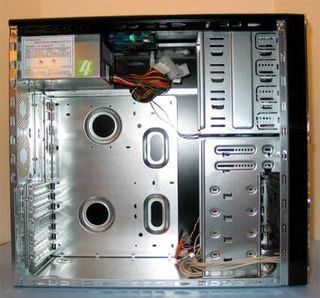2003 Winter Case Review Part 2: The ATX Avalanche
Aspire: X-Dreamer II, Continued
Checking in with a low MSRP of only $79.00 US, the X-Dreamer II from Aspire attempts to deliver an interesting blend of what consumers want at a price they can afford. Certainly the quality of the X-Dreamer II case is not what you would find in an aluminum chassis at twice the price. Weighing in at just less than 20 pounds, the X-Dreamer II is not going to be in the same class with other high-end cases. Still, it does do many things well, when the affordable price is factored in. Looking at the inside of the X-Dreamer II it is obvious that we have almost taken a trip back in time. The construction is quite a bit different from what will be found in other cases that are pricier. There is a demand for more cost effective case solutions, and the X-Dreamer II fits well into that category. During our examination of the X-Dreamer II we did find several glitches that might be deal breakers for some, but overall the case really is not a bad offering for the price.

A look at the inside of the X-Dreamer II.
The X-Dreamer II uses a variety of construction techniques. These techniques consist mostly of rounded and folded edges with a clean type finish. While this case is somewhat cramped inside, it was reasonably easy to assemble. We encountered significant bend and some twist in the X-Dreamer II. Aspire has attempted to combat some of the lack of structural sturdiness by using a series of l-shaped brackets in the corners of the case. Overall, the construction quality is fair. Given Aspire's choice of materials it is understandable how this case was built.
One of the highlights of the X-Dreamer II is Aspire's use of bezel bay covers to hide the optical drive bezels as well as the floppy drive bezel. While black floppy drives are fairly common, as are black optical drives, the need for these bezels is more to present a uniform appearance than anything else. The quality of the optical drive bezels was fairly good. After installing our optical drive we continuously opened and closed the drive to get an idea of the door action. The bezel, for the most part, was more than acceptable; however, we judged the spring action to be somewhat weak. The floppy bezel cover, however, was a different story. We had some difficulty getting it to line up properly and experienced some "hangs" during the floppy eject process. Inherently, getting the floppy bezels to fit well is somewhat more difficult than the optical drive bezels. Overall, we were satisfied with the results.
Stay on the Cutting Edge
Join the experts who read Tom's Hardware for the inside track on enthusiast PC tech news — and have for over 25 years. We'll send breaking news and in-depth reviews of CPUs, GPUs, AI, maker hardware and more straight to your inbox.
Current page: Aspire: X-Dreamer II, Continued
Prev Page Aspire: X-Dreamer II Next Page Aspire: X-Dreamer II, ContinuedMost Popular

